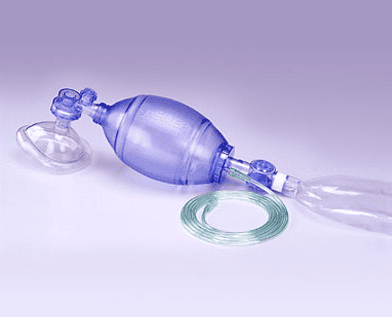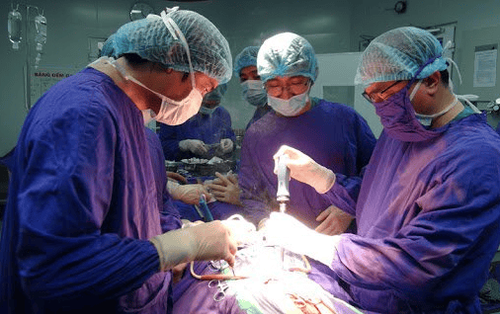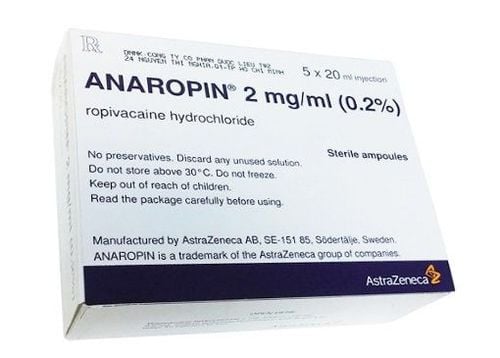This is an automatically translated article.
The article was professionally consulted by Specialist Doctor II Nguyen Binh - Department of General Surgery - Vinmec Ha Long International Hospital. Doctor Nguyen Binh has more than 20 years of experience in the field of anesthesia and resuscitation.Pregnant women with asthma may be indicated for a cesarean section. Endotracheal anesthesia for cesarean section on asthmatic pregnant women to control the patient's respiratory activity during and after surgery.
1. Overview of endotracheal anesthesia for cesarean section in asthmatic pregnant women
In cesarean section on pregnant women with asthma, the technique of general anesthesia with intubation, also known as endotracheal anesthesia, is used to control the patient's breathing during and after surgery. surgery, is indicated in cases where the pregnant woman contraindicated or refuses regional anesthesia.2. What should be prepared when endotracheal anesthesia for cesarean section on asthmatic pregnant women?
To perform endotracheal anesthesia for cesarean section on pregnant women with asthma, the following facilities, machines, equipment and medications are required:The system includes an anesthetic machine (with breathing), oxygen hand squeezer , machine to monitor vital indicators (such as arterial blood pressure, breathing rate, temperature, ECG, EtCO2, SpO2), suction machine, defibrillator, ... Endotracheal tube sizes to place, laryngoscope, mask, straw, oropharyngeal cannula, squeeze bulb, soft mandrin, Magill pliers. Salbutamol and Lidocaine 10% spray. Other means of supporting endotracheal anesthesia for cesarean section in pregnant women with asthma to prevent difficult intubation: laryngeal mask, Cook tube, flexible bronchoscope, mouth opener, tracheostomy set , ...

3. Procedure for endotracheal anesthesia for cesarean section on asthmatic pregnant women
Before performing surgery, patients need to be examined under anesthesia to promptly detect and prevent possible risks, as well as evaluate difficult intubation status. Assess the status and severity of maternal asthma by measuring peak expiratory flow, frequency, and acute asthma attacks.Procedures for endotracheal anesthesia for cesarean section on pregnant women with asthma include the following steps:
Step 1: Put the patient in a supine position, at least 5 minutes before induction of anesthesia, give 100% oxygen with dosage 3 - 6 liters/min. Install machines to monitor and set up transmission lines. If necessary, the patient can be given sedatives from the night before surgery. Step 2: Initiation of anesthesia begins with intravenous injection (drugs: propofol, ketamine,...), analgesics (fentanyl, sufentanil, ...), using muscle relaxants if necessary (rocuronium, succinylcholine, .. .). It is necessary to ensure the conditions for endotracheal intubation during cesarean section on asthmatic pregnant women (patients sleep deeply, muscles relax enough). Step 3: Conduct oral intubation as follows: (1) Perform rapid induction of anesthesia and perform the Sellick maneuver when the stomach is full (as soon as the patient loses consciousness, press the cricoid 20 - 30 kg). until endotracheal intubation is complete); (2) Open the patient's mouth, place one hand under the neck to keep the neck in an upright position, insert the laryngoscope into the right side of the mouth, move the tongue to the left side of the mouth, insert the light deeply, and combine Use the right hand to press the cricoid cartilage to find the lid and glottis; (3) The next step in endotracheal anesthesia for cesarean section in pregnant women with asthma is to gently insert the endotracheal tube through the glottis, when the endotracheal tube is about 2-3 cm across the vocal cords, stop; (4) Intubation of endotracheal balloon; (5) Gently withdraw the laryngoscope; (6) Listen to the lungs, see the EtCO2 index to check that the endotracheal tube is in place; (7) Use adhesive tape to fix the endotracheal tube. In case, if it is necessary to avoid biting the endotracheal tube, the cannula can be placed into the patient's mouth. Note, apply difficult intubation procedure for difficult intubation cases. Step 4: The next step in anesthesia for cesarean section intubation in pregnant women with asthma is to maintain anesthesia with anesthetics (intravenous or vapor), analgesics, muscle relaxants (if necessary) and control Control the patient's breathing with a machine or hand squeezer.

4. Monitoring during endotracheal anesthesia for cesarean section on asthmatic pregnant women
During endotracheal anesthesia for cesarean section on pregnant women with asthma, it is necessary to monitor the following signs and indicators:Depth of anesthesia: Monitor blood pressure, heart rate, blood pressure, sweating status sweat, tears, BIS, MAC, Entropy (if any) ... Vital signs: Monitor blood pressure, heart rate, body temperature, EtCO2, SpO2 indicators. Monitor in case of wrong position of endotracheal tube, or blocked, folded tube. At the end of the process of endotracheal anesthesia for cesarean section on asthmatic pregnant women, the following criteria should be met before extubation:
The patient is awake and can follow orders. Breathe spontaneously, breathe evenly, breathing rate is within normal limits. Blood pressure and pulse are stable. Body temperature over 35 degrees Celsius. Raise head >5 seconds, TOF index >0.9 (if any). The patient had no complications from anesthesia and surgery.

5. Management of complications after endotracheal anesthesia cesarean section in pregnant women with asthma
During endotracheal anesthesia for cesarean section on pregnant women with asthma, there may be some complications that need to be treated as follows:Gastric reflux: When digestive juices are detected in the oral cavity. and airway, immediately drain the fluid, place the patient in a low lying position and tilt the head to the side. Rapidly intubate the endotracheal tube and remove all fluid from the airway. Monitor patients for lung infections after surgery. Hemodynamic disorders: Depending on the cause and symptoms such as arrhythmia, increase or decrease in blood pressure, ... will be treated appropriately. Difficult intubation during cesarean section anesthesia in pregnant women with asthma: Switch to difficult intubation procedures or proceed to another method of anesthesia. Misplaced endotracheal tube into the stomach: Re-intubate the endotracheal tube when misplaced with symptoms of auscultation of the lungs without alveolar murmurs, no measurement of EtCO2. Constriction of the larynx, trachea, bronchi: Complications in endotracheal anesthesia for cesarean section on asthmatic pregnant women may cause difficulty or inability to ventilate, at this time there will be a hissing sound in the lungs or may also mute lung. For management, it is necessary to provide adequate oxygen, and at the same time give sleeping pills and muscle relaxants, bronchodilators and corticosteroids to ensure ventilation. In case of respiratory failure, difficult intubation procedure should be applied. Trauma in endotracheal intubation: Depending on the damage such as tooth fracture, bleeding, foreign body in the airway, ... will be treated appropriately. Respiratory complications: Find and treat the cause, ensure ventilation and provide 100% oxygen when endotracheal anesthesia for cesarean section in pregnant women with asthma causing respiratory complications such as folded endotracheal tube, drop or push deep into one lung, open or drop the respiratory system, the oxygen runs out, the effect of soda is gone, causing hypoxia. Complications after extubation: Depending on the cause, choose appropriate management when symptoms appear after extubation such as respiratory failure, hoarseness, sore throat, laryngospasm, gas trachea, bronchi, laryngotracheal and tracheal stenosis, upper respiratory tract infection.

6. Requirements to note when performing cesarean section endotracheal anesthesia on asthmatic pregnant women
When performing endotracheal anesthesia for cesarean section on asthmatic pregnant women, the following requirements should be noted:Based on respiratory function, assess the severity and stage of asthma. Pregnant women with asthma are at increased risk of aspiration and bronchospasm due to increased airway tone during intubation. When intubating with inhaled beta 2 adrenergic agonists and portal corticosteroids (hydrocortisone) care should be taken to prevent asthma attacks. Administering Propofol or ketamine to pregnant women with asthma may induce rapid induction of anesthesia. Rapid and conscious intubation with local anesthetics and beta-adrenergic agonists may increase the risk of aspiration when the mother loses airway reflexes. Once the asthma is stable, spinal anesthesia or epidural anesthesia may be chosen for cesarean section. Endotracheal anesthesia for cesarean section on asthmatic pregnant women should be noted and prevent possible risks.
Endotracheal anesthesia is a routine anesthetic technique performed at Vinmec International General Hospital. Accordingly, the procedure of endotracheal anesthesia at Vinmec is carried out methodically and in accordance with standard procedures by a team of highly skilled doctors and modern machinery. As a result, complications after anesthesia and surgery are always minimized to the maximum extent.
Please dial HOTLINE for more information or register for an appointment HERE. Download MyVinmec app to make appointments faster and to manage your bookings easily.














